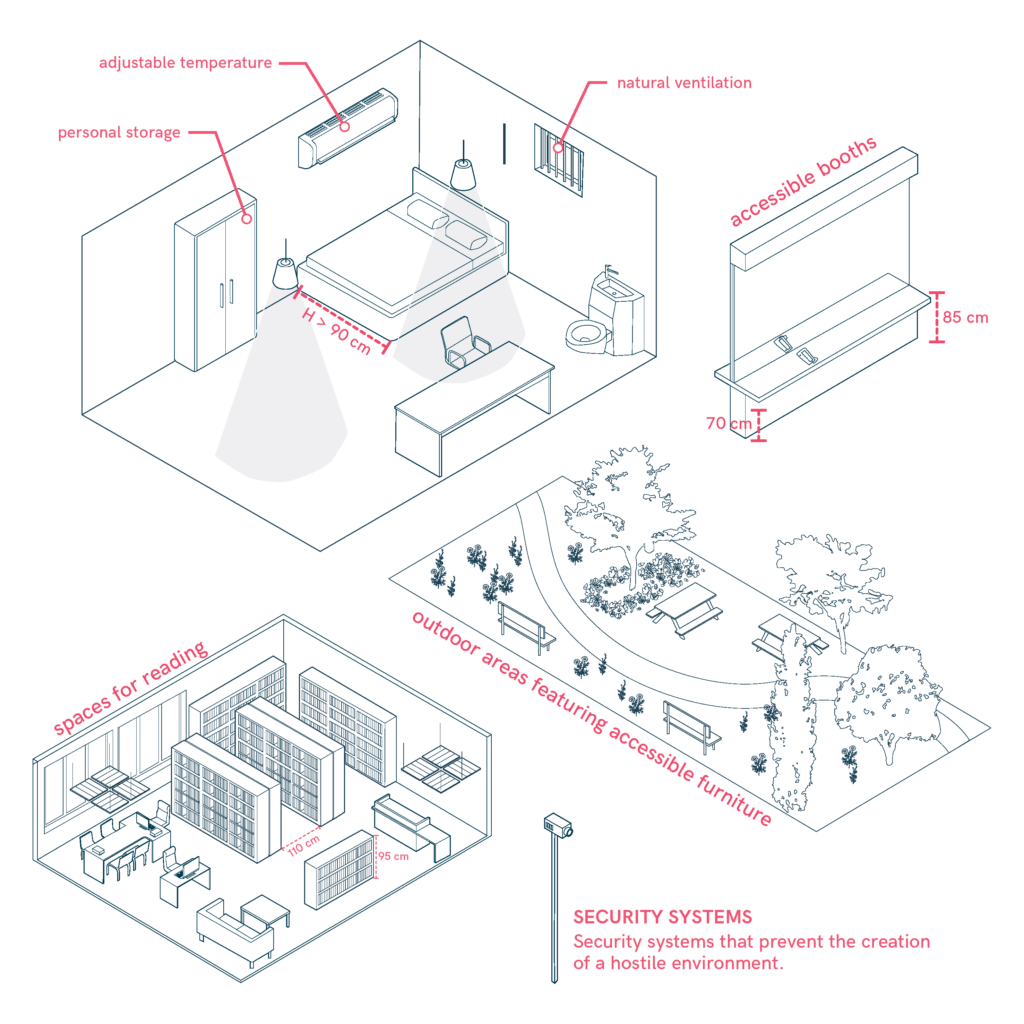Cells and Detention Spaces
Detention facilities must guarantee accessible and dignified conditions, providing a safe and functional environment that supports the wellbeing of individuals deprived of liberty and their reintegration process. The design of these spaces should avoid precarious configurations and instead offer solutions that promote autonomy, health, and personal development. All categories of cells must include accessible options, with functional bathrooms that balance privacy and mobility. Beds should allow manoeuvring for wheelchairs, while benches and water fountains must be adapted for different users. Furthermore, visiting areas should include accessible booths on both sides, promoting equitable communication between detainees and visitors.

- Each facility must have accessible cells in the main detention areas, with natural ventilation, adjustable temperature, and adequate lighting.
- Accessible facilities with individual showers, toilets separated by partitions, and adapted washbasins.
- Beds with a manoeuvring space of at least 90 cm, comfortable mattresses, desks with ergonomic chairs, and shelves for personal storage.
- Quiet spaces for individuals who experience stress or suffering due to overstimulation.
- Water fountains adapted to various heights and accessible benches with adequate back support.
- Accessible booths on both sides and service areas with adapted counters, ensuring dignified encounters without unnecessary barriers.
- Spaces for reading, training, and work, with libraries and outdoor areas featuring accessible furniture and greenery.
- Activity programmes that promote cohesion and good mental health.
- Thermal and acoustic control to ensure comfort, reducing extreme temperatures and excessive noise.
- Security systems that prevent the creation of a hostile environment.
- Create pleasant, non-hostile spaces that promote wellbeing for individuals deprived of their liberty.
Sources
- https://hchr.org.mx/comunicados/onu-dh-anima-a-las-proximas-autoridades-a-garantizar-condiciones-dignas-para-las-personas-privadas-de-la-libertad/
- https://accessible-eu-centre.ec.europa.eu/content-corner/digital-library/en-172102021-accessibility-and-usability-built-environment-functional-requirements_en
- https://www.access-board.gov/adaag-1991-2002.html#purpose
- https://observatorio2030.com/sites/default/files/2024-07/HABITATU%20-%20Guia%20para%20cruzar%20los%20limites%20de%20la%20normativa%20-%20CAST.pdf
- Carers
- Children
- Cognitive
- Cognitive abilities
- Decolonial perspective
- Digital
- Digital barrier
- Enviroment
- Environmental
- Gender and generations
- Gender perspective
- Hearing impairment
- Low-education
- Low-income
- Older people
- Other
- Physical abilities and features
- Sensory and Physical
- Socioeconomic
- Visual impairment